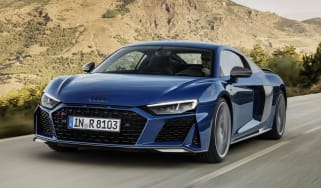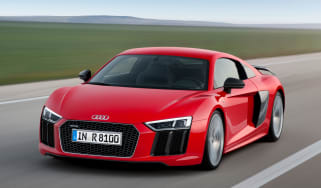Audi R8 Spyder convertible
"The Audi R8 Spyder has the performance to match its looks and is the pick of the R8 range."
Pros
- Exhilarating V10 engine
- Just as good to drive as the R8 coupe
- Beautifully engineered electric roof
Cons
- Restricted luggage space
- Steering lacks feel
- Expensive options
The Audi R8 has been around long enough now that it’s become something of a modern classic rather than the futuristic sports car it was when it first launched. An all-new coupe has already been introduced in an attempt to keep the car looking sharp and the latest convertible version, called the R8 Spyder, is now here, too.
Styling changes compared to the previous model are relatively minor, but the R8 Spyder has been reinvigorated and is still very striking thanks to a more muscular, aggressive look and tighter lines. There’s no longer a V8 version, so you’re ‘forced’ into the spectacular 532bhp 5.2-litre V10 engine that gets the car from 0-62mph in 3.6 seconds, or the brutally fast R8 Plus, which has a 602bhp version of the same engine. The Plus will do 0-62mph in just 3.3 seconds.
The R8 Spyder uses a fabric roof that can be put up or down in 20 seconds at speeds of up to 31mph and features the beautifully designed ‘Virtual Cockpit’ display already seen in the R8 coupe and Audi TT. It’s quiet and calm inside the car with the roof up or down and it’s better than ever to drive on a twisty road.
More reviews
The R8 Spyder is a brilliant convertible sports car that’s just as quick and rewarding to drive as the coupe. In fact, the compromises are so few that we think it’s the R8 to buy if you can stretch to the higher price. The only question is whether you’ll be tempted by rivals such as the McLaren 570S Spider, the Jaguar F-Type Convertible or the Mercedes AMG-GT C.
MPG, running costs & CO2
A 5.2-litre V10 engine is never going to return impressive economy figures, but that won’t be a problem for prospective buyers of a £130,000 performance car. The R8 Spyder is about speed and style, not getting you from A to B cheaply, and an officially economy figure of 24.1mpg only serves to confirm this, even if it’s a 10% improvement on the previous model. The extra power of the R8 Plus means official economy drops to 22.6mpg.
Bear in mind that you’ll struggle to match figures for either model in the real world, particularly if you enjoy them as intended – when we drove the coupe version of the standard R8 Spyder, both of which have the same engine, we were getting around 12mpg!
CO2 emissions stand at 277 grams per kilometre (g/km) for the R8 and 292g/km of CO2 for the R8 Plus. The car costs £450 a year to tax from the second to the sixth year of ownership.
Ironically, changes made to the way VED works in April 2017 mean the R8 is slightly cheaper to tax than it was before.
Going for larger wheels will increase CO2 emissions slightly and make tyres marginally more expensive to replace. Whichever of the wheels on offer you go for, consumables like tyres and brakes will be pricy.
Servicing the car will cost either £500 or £1,000 depending on whether it’s minor or major (they alternate). The R8 Spyder, like all new Audis, comes with a three-year/60,000-mile warranty.
Engines, drive & performance
The convertible version of the R8 gets the same 532bhp 5.2-litre V10 engine as the coupe and it sounds and feels even better without a roof on the car. The R8 Spyder will do 0-62mph in 3.6 seconds, and the sound and drama of the V10 during hard acceleration is addictive.
This is ramped up in the R8 Plus model, which has a 602bhp version of the same V10 engine and is capable of 0-62mph in 3.3 seconds. The extra power makes the R8 Plus even more exhilarating and there really is little else on the road to match it in terms of sheer, glorious noise.
The R8 Spyder is lighter than the previous one, but just as important is the fact it’s also considerably stiffer, which makes performance even better than before. A dual-clutch automatic gearbox comes as standard and it’s quick and smooth. The R8 Plus is another 25kg lighter than the ‘basic’ Spyder, enhancing performance even further.
The Spyder’s dynamic steering system makes for very precise, accurate cornering and although there isn’t much feedback through the steering wheel itself, the car is still very enjoyable to drive quickly. In some ways, the fact that the R8 Spyder has fractionally softer suspension than the coupe to make it a better cruiser means the steering actually has a nicer feel to it.
Interior & comfort
We’ve become accustomed to modern, minimal, high-quality, luxurious interiors from Audi’s designers and the inside of the R8 Spyder certainly doesn’t disappoint. Leather with tactile metal and carbon trim lines the cockpit, and it has a smart design that feels fitting of such an expensive car.
While the interior is more an exercise in understatement than drama, it has a look that should be easy to live with and still look smart in the future. Another nice touch is Audi’s Virtual Cockpit, first used in the latest Audi TT, which replaces traditional dials with a 12.3-inch TFT display.
The Spyder comes with a wind-breaker that can be raised or lowered, but with it up the inside of the car is free from almost all the buffeting you might expect of a convertible.
The roof is completely electric and can be put up or down at speeds of up to 31 mph in around 20 seconds. It’s very quiet inside when it’s raised.
Practicality & boot space
A two-seater convertible capable of almost 200mph is never going to make the most practical car and the Audi R8 Spyder lives up to that billing. The boot, which is actually in the nose of the car as the engine is behind the seats, will hold 112 litres, which is at least the same as the R8 coupe, but only gives you luggage space for a couple of smallish soft bags.
Reliability & safety
The V10 engine in the R8 is tried and tested, and much of the other technology, such as the Virtual Cockpit, has already been used in other Audi cars. The R8 isn’t sold in sufficient numbers to be included in our 2016 Driver Power customer survey, but Audi as a brand came a rather underwhelming 21st out of 32 in the manufacturer chart. The overall score included a 23rd place in the reliability category, but a more impressive sixth for build quality.
The R8 Spyder hasn’t been crash-tested by Euro NCAP, but it should prove a very safe car despite how fast it is. There are plenty of stability systems on board and all cars get Audi’s quattro four-wheel-drive system for even more grip than is generated by the car’s wide tyres. Ceramic brakes are an expensive option, but give you the ultimate in stopping power.
Price, value for money & options
The options list for the Audi R8 Spyder features some slick, tempting extras but most of them are eye-wateringly expensive. Exclusive paint finishes are £2,500, a gloss carbon styling pack is £4,900 and 20-inch black alloy wheels look great but will cost £2,350. LED laser headlights are £3,150, ceramic brakes are £7,700, bucket seats are £3,000, while a Bang & Olufsen stereo is £1,750. A few clicks of the mouse on Audi’s online R8 Spyder configurator can easily add £30,000 to the cost of the standard car. The one option we would definitely recommend considering is the Magnetic Ride adaptive dampers at £1,600, as it does make the R8 feel even more settled on uneven roads.
Despite sharing many parts with the Lamborghini Huracan Spyder, including the V10 engine, the R8 Spyder is around £70,000 less to buy. While the standard R8 does have slightly less power than the Lamborghini, a more powerful R8 Spyder Plus is likely and should still represent a hefty saving over its Italian counterpart.
If you’re considering an R8 Spyder, you might also want to look at the range-topping Jaguar F-Type convertible, the SVR model. It’s actually more powerful than the Audi, with 567bhp and undercuts it by around £15,000. A convertible version of the Mercedes-AMG GT will arrive shortly and is likely to be around the same price as the R8 Spyder but offer around 549bhp.











